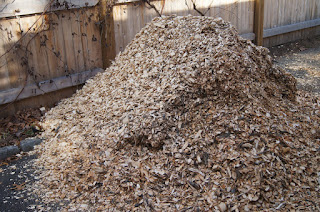My silk tree has gone to its reward, leaving a space for a new tree. This week I received a little common or Eastern persimmon, Diospyros virginiana. The Latin genus name means “food of the gods”!
 |
| Ready to plant |
This native persimmon produces fruits around the size of golf balls. My goal in planting it is to provide wildlife with food and habitat. Maybe there will be a few persimmons for human residents of the yard too.
 |
| 'Yates' persimmons from a tree like mine. Grown by Hank and Nghi Frehtling in Willianston, MI in 2013 |
So
yesterday I went out with my shovel to plant the little tree. Over the last few
years I’ve collected quite a list of does and don’ts for planting shrubs and
trees. First there was the hole. When I started out, I used to think that a
deep hole was good, because loose soil under the young plant would make room
for its roots. Lots more is known now about tree roots. They spread mostly
sideways, not down. Persimmons reportedly send down a tap root to lower depths,
but still, most of the feeder root action will be near the surface where the
oxygen is. You can set your tree back considerably by planting it too deep. Today’s
planting holes are supposed to be wide but no deeper than the root ball.
As
usual when I dig in my yard, my hole quickly revealed sizable roots.
Surrounding trees and shrubs were clearly spreading their roots far and wide. I hoped that my relatively small hole, two feet in diameter, would not do enough root damage to harm the new tree’s neighbors.
The next step was a bold one. I’ve always been hesitant to mess with the root balls of container- grown plants. But recently I read about an experiment demonstrating that transplanted trees actually did better if the roots were cut back. Cringing a bit, I teased out the potting soil around my little tree’s roots and trimmed away some of the longest roots. I made sure to set the now-floppy mass of roots on a pyramid of soil to keep the stem above ground level.
 |
| This root crossing the hole had to be left alone |
Surrounding trees and shrubs were clearly spreading their roots far and wide. I hoped that my relatively small hole, two feet in diameter, would not do enough root damage to harm the new tree’s neighbors.
The next step was a bold one. I’ve always been hesitant to mess with the root balls of container- grown plants. But recently I read about an experiment demonstrating that transplanted trees actually did better if the roots were cut back. Cringing a bit, I teased out the potting soil around my little tree’s roots and trimmed away some of the longest roots. I made sure to set the now-floppy mass of roots on a pyramid of soil to keep the stem above ground level.
 |
| After the radical treatment |
 |
| Before-fresh from the container |
I restrained myself from “improving” the backfill with fertilizer or compost. That too turns out to be misguided. It’s best for your transplant to be surrounded with the same soil you dug out of the planting hole. I watered generously and surrounded the young tree with some handy wood chips.
Last
I had to decide about the stake that came with the plant. It was tightly attached to the stem with five
plastic ties. I knew that staking trees is over-rated, and young trees actually
grow faster and stronger if they’re allowed to sway with the breeze. I decided
to keep the stake until the new tree put out some leaves, just to prevent me
from trampling it by mistake. I cut off all but the top two plastic ties.
I’ll need to be sure to remove the last two soon, because as the stem expands, the unyielding plastic could girdle the trunk, cutting off the flow of nutrients under the bark.
 |
| These ties seem especially tight |
I’ll need to be sure to remove the last two soon, because as the stem expands, the unyielding plastic could girdle the trunk, cutting off the flow of nutrients under the bark.
I
read that a persimmon could produce fruit in as little as three years. I can’t
wait!











